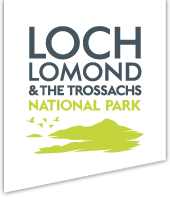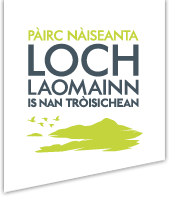
Fault Lines of the Trossachs: Ecologist Alan Bell speaks to Hidden Scotland
Fault Lines of the Trossachs: Ecologist Alan Bell speaks to Hidden Scotland
How does the geology of the Highland Boundary Fault Line continue to shape the landscape and lives of people in Scotland’s first National Park, and beyond?
For the latest issue of indie print magazine Hidden Scotland, travel writer Laura Anne Brown wanted to explore this question. So she spoke with people across the country, from artists and cyclists, to hotel owners and geologists.
One of them was Alan Bell, the National Park Authority’s Heritage Programme Manager. Their conversation is shared here in full.
Tell me a bit about yourself, Alan.
Long ago, in the Year 2000, I was working for Scottish Natural Heritage in the team that led the public consultation about the idea of setting up Scotland’s first ever National Park in Loch Lomond and the Trossachs. Then in 2004 I was successful in being recruited as the first Ecologist for the new National Park Authority. These days, I’m our Natural Heritage Programme Manager, working to help deliver our programme of work for nature restoration and landscape in the National Park.
What does that involve, day to day?
I run our team who undertake peatland restoration projects, particularly on our extensive areas of blanket bog. I also run our team who provide landscape, ecological or woodland advice in relation to our role as the Planning Authority. Our role there is helping to make sure that development proposals are thoroughly scrutinised and evaluated in relation to the statutory purposes of the National Park. Complex planning applications and the demands of national infrastructure invariably involve my team in providing specialist expert advice to ensure nature is protected as part of any planned developments. We also have an important role in advising on woodland creation and management proposals.
A lot of busy, important work! I wanted to speak to you specifically about the Highland Boundary Fault Line. With your background in ecology, could you explain it in really simple terms to someone who may not have heard of it?
The Highland Boundary Fault is the remains of a gigantic geological car crash where two tectonic plates collided and created a spectacular crumple zone. It created huge Alps-sized mountains to its north and west, which after millions of years of glaciation and erosion are the Scottish Highlands we love today. It also left an ancient rift valley of softer sedimentary rocks to its south and east, now known as the Central Belt of Scotland. It means a combination of wild mountains of infertile metamorphic rock, glacier-carved valleys and deep cold lochs, all sitting right next door to flat, fertile farmland and our great industrial cities built on the legacy of coal fields and steam power. Hence, we now have roughly 50% of Scotland’s population living within an hours’ drive of this truly spectacular place we call the National Park.
I’m curious to understand how the Boundary Fault still shapes the National Park today. For example, how might I notice the fault line in the landscape?
The Highland Boundary Fault cuts right through the National Park. It’s why Loch Lomond is broad, shallow and nutrient rich at the southern end and narrow, very deep and nutrient poor at the north end. It’s also why mountains in the Park like Ben Lomond or Ben Ledi are such amazing hill walks. Stand on their summits at sunset and you get spectacular views of apparently infinite mountains extending to the northwest and seemingly endless plains to the south and east. Face one way and the setting sun silhouettes the mountains. Face the other way and its last rays reflect off the far away Wallace Monument at Stirling or glint on distant tower block windows in Glasgow. 360 degrees of poetry and magic.
‘360 degrees of poetry and magic’ – I love that, and couldn’t agree more. I’m wondering then, what about the challenges that the geology brings?
The biggest challenge, that led directly to the National Park being established, is people. About 15,000 people live in the Park but millions live near it. And we love the place. Ever since steam power was invented, it’s been our playground. Our wooded loch shores, our hills and mountains are like some powerful people-magnet. In good summer weather it feels like everyone wants to visit it at once. One of our biggest tasks is managing all of these visitor aspirations alongside the day-to-day needs of the residents. And seeking to help manage all of that alongside modern land uses for timber and farming in ways that work well for climate and nature too.
As someone who grew up on the west coast, I’ve definitely had my fair share of childhood summer day trips to Loch Lomond! What about other creatures, how does the Highland Boundary Fault influence their habitats?
The National Park is an incredibly important place for nature, again shaped fundamentally by its geology. In particular, the mountains mean that it rains a lot, with up to 4 metres of rainfall per annum in places. That gives us our upland blanket bogs of deep peat and extensive winter snow and frost too. We have Arctic Alpine plants and birds on our mountains, fish including Arctic charr, powan and salmon on our lochs and rivers and some of the largest native woodlands in Scotland on the lower slopes of our mountains. These support red squirrels, pine martens, red deer, huge populations of woodland birds and insects and a great diversity of mosses and lichens, all living in what we now recognise as temperate rainforest. You can honestly say that golden eagles live here because of our geology.
Speaking with you, the Highland Boundary Fault seems even more influential to the National Park than I initially thought. How do you hope to engage a bigger audience with the geological significance of the Park this year?
Currently the geological significance of the National Park is being vividly expressed through the alarming landslips that have troubled the A83 through the Arrochar Alps at the Rest & Be Thankful. We have a jaw-dropping mountain pass twisting through tall mountains with very high rainfall. The rain runs down steep unstable slopes where the debris left by vanished glaciers has been re-mobilised since the current road was designed in the 1940’s. We need that road to get to the rest of Argyll as well as to local settlements like Lochgoilhead.
Of course! My dad works around the west coast and has to travel that way often. It’s an important road but must be a hard one to maintain given its exposed location.
Thankfully it looks like the hard-pressed engineers, with continued input from the National Park team, have now come up with a good solution that will let us redesign that road so that it stays reliable and safe, whilst still fitting into the spectacle of the wild mountain scenery. We hope that will keep everyone engaged in a good way!
Finally, on a personal level, in what ways does the landscape of the National Park inspire you?
For me, it all started because I grew up in Glasgow. Gazing across the Clyde at Greenock to the mountains of Cowal. Realising that I could see the snowy summit of Ben Lomond in the distance on my walk home from school. That high point on the M80 near Stirling where suddenly the Highlands appear. Those things led me to walking the West Highland Way when I was a kid and bagging my Munros. They still get me every time I see them. Give me a chance for a dip in Loch Lomond on a sunny summer evening, when the water’s not completely freezing, and in I’ll go. It all just makes me feel both amazed and human.
That answer took me back to my own childhood growing up south of Loch Lomond. How lucky are we to call such a special place home! Thank you so much for your time, Alan.
Read the full Highland Boundary Fault feature in issue 10 of Hidden Scotland.

